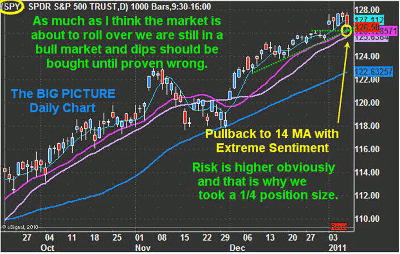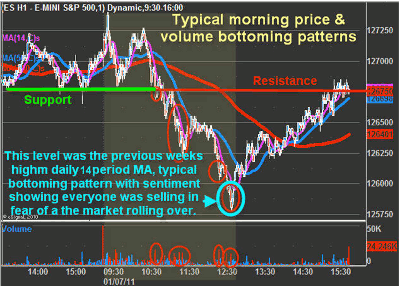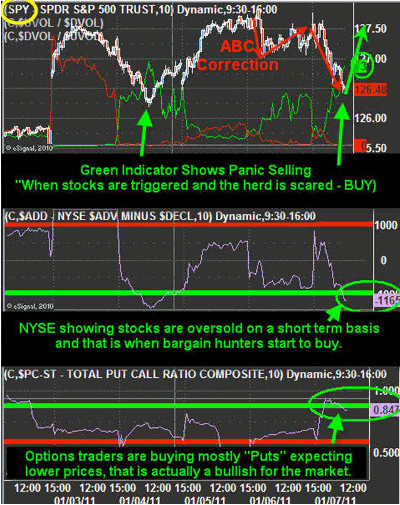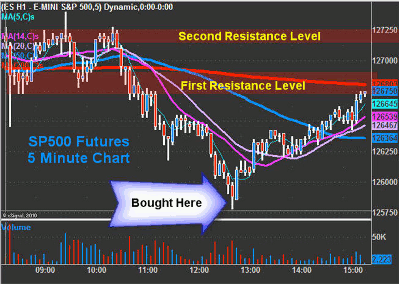On Friday, the market generated some very good short-term trading signals to go long the overall market. It’s an excellent example of how I look for short-term bottoms.
This trade seemed to fall on a perfect day because if we look back over last year’s weird trading characteristics, if you were to buy on a Friday and hold that position until Monday, typically, it would have netted you a profit. On Friday, the market had a very nice intraday pullback to a level where there was strong support, so we bought in with a small position.
Let’s jump into the charts for a visual of what I am talking about.
SPY: Daily Chart and Moving Averages
This chart shows the big picture. Currently, we are in a strong uptrend and looking to buy significant pullbacks to key levels of support, and that is exactly what we had last week.
The market pulled back to a level that has support:
1. It pulled back to the 14 day moving average
2. It pulled back to the previous weeks high
3. It pulled back to a support trend line
Each of these levels happen to be at the same level, and each type of support will attract a different type of trader, meaning there should be a lot of individuals covering their shorts and/or buying at that point.
Let’s take it step by step and learn from this example:
Friday’s One-Minute Madness Chart
This is a one-minute chart of just last Friday (Jan. 7) scrunched together so I can fit everything into one chart. What I want to show here is how the short-term time frame can help you spot a bottom as it is forming. This actually is a little more complicated that I’m showing here, but I hope you get the point.
Every day there is either a short-term top or bottom, which usually forms between 10 am and 2 pm ET. When the daily chart is in an uptrend, you should focus on only trying to play bottoms as the bias is up, and even if your timing is off a little, the overall larger trend typically will save your butt.
The chart below shows how a morning support level was broken and the market started to fall. That is the first time in the day where stops get triggered and the start of a new trend was born. The jump in volume was from traders who were long and used the morning support as a level to exit the position if it was broken in order to cut their losses. Bearish traders, on the other hand, would have been shorting on the breakdown and anticipating lower prices.
Usually after a break there is a test of the breakdown level, and we got that a few minutes later, at which point more traders took short positions hoping for continued selling. That wave of selling led to a sharp drop and then the first real bounce.
My general rule is you can trade the first pullback after a breakout or price surge. Now this can be taken two ways: You can trade the first test of a breakout, which, in my opinion, carries the lowest risk, and then you can still trade the first real bounce, which comes after strong and steep price movement.
When looking for the bottom, I like to see multiple new lows with price spikes as it means stops are being triggered, and more traders keep shorting the new lows. Once the herd is heavily weighted on the short side and the chart forms an ABC retrace, then I know a bottom is near and all those shorts will be covering sooner rather than later.
NEXT: Tracking Sentiment Using Ten-Minute Charts
|pagebreak|Market Sentiment Trading Indicators: Ten-Minute Charts
Let’s take a look at a few ten-minute charts below:
Top Chart: The SPY ETF shows a possible ABC correction on the ten-minute chart along with panic selling as there were three sell orders to every buy order. Everyone was running for the door.
Middle Chart: The NYSE Advance/Decline line was showing stocks were oversold on a short-term basis, and it’s just a matter of time before the price stabilizes or bounces.
Bottom Chart: The put/call ratio was telling me even the options traders were buying leverage to the down side. All of this tells me the majority of traders are selling, and I often like to take the opposite tact.
S&P 500 Futures: Five-Minute Chart from Friday
This shows where our entry point was using all the above indicators and trading analysis. Because the broad market has been rising for so long and showing signs of correcting any day now, a trader must be very timely with their entry point and the amount of money put to work in these trades. But just because the market feels like it’s ready to roll over, it does not mean we should be looking to go short. I strongly believe we buy the dips, but keep our position sizes much smaller than normal. For all we know, this uptrend could go on into May!
During an overbought/overextended market condition—which I think most of us agree we are in—I am not willing to risk much capital in new positions, and also, the reason why I am really zooming in on the charts to get us the best possible price to reduce risk.
Last week’s entry point required us to be very timely, but keep in mind this is not the norm. During a new trend, we sometimes have two to three days to enter a position before the market starts to really move, and it is those larger swing trades which make great money and can last for weeks.
By Chris Vermeulen of TheGoldandOilGuy.com

























